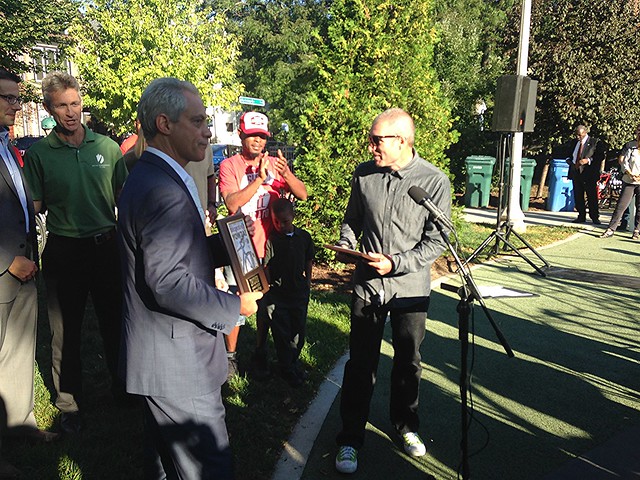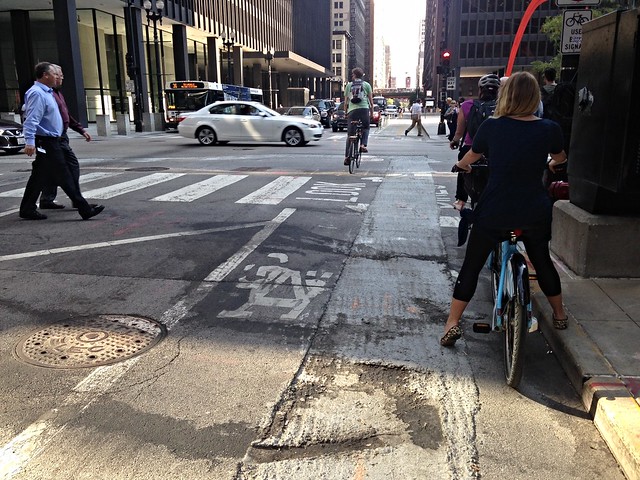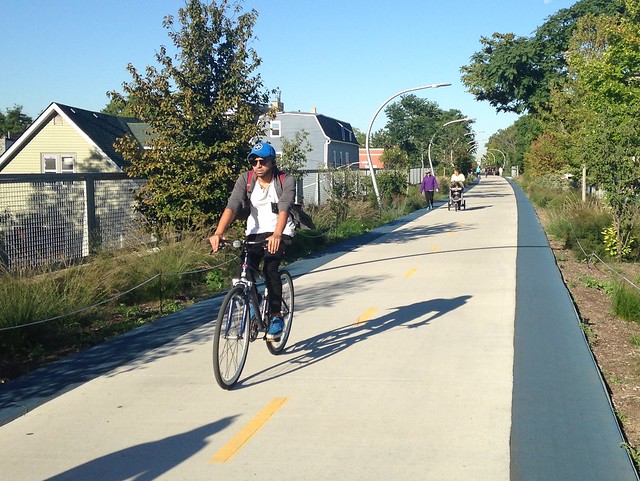This morning’s announcement that Bicycling magazine has ranked Chicago as the best cycling city in the U.S. in its biennial ratings, up from second place to New York in 2014, was surely a head-scratcher for many people who ride bikes in our city on a regular basis.
As of 2015, our bike mode share was a mere 1.7 percent of all trips to work, less than a quarter of Portland’s 7.2 percent mode share. While Chicago has built plenty of buffered and protected bike lanes, we don’t have a cohesive, intuitive network of low-stress bikeways, in contrast with Minneapolis, where it’s possible to bike from many neighborhoods to the central business district via off-street paths. Our conventional bike lanes are often clogged with illegally parked vehicles, torn up for utility work, or dangerously obstructed by construction projects. And then there’s the fact that four people were fatally struck by allegedly reckless drivers while biking in Chicago over a roughly two-month period this summer.
Still, I think one can make a case that, with all of the strides our city has made over the last five years to improve cycling, we do deserve an award as the large U.S. city that is doing the most things correctly to get more people on bikes and make cycling safer. Let’s look at some of the arguments for this point of view. Here’s the magazine’s top ten ranking for 2016:
- Chicago
- San Francisco
- Portland, OR
- New York
- Seattle
- Minneapolis
- Austin
- Cambridge, MA
- Washington, D.C.
- Boulder, CO
The Bicycling write-up of Chicago’s cycling strengths notes that the city built 100 miles of next-generation bike lanes within Mayor Rahm Emanuel’s first term in office. Thankfully, they didn’t say that 100 miles of protected lanes were built, as the city has often claimed, but rather, “Emanuel made good on a promise to build 100 miles of buffered and protected bike lanes.” Even that’s not technically accurate, since Emanuel originally pledged to build 100 miles of physically protected lanes, and only wound up putting in 19.5 miles of PBLs, plus 83.5 miles of buffered lanes. Still, that was a major achievement.
The magazine also cites the Divvy bike-share system and the Divvy for Everyone equity program, the use of concrete curb protection for bike lanes (many new curb-protected lanes are currently planned), the upcoming 35th Street bike-ped bridge, and the in-progress construction of Big Marsh bike park as reasons for the ranking. The article doesn’t even mention the Bloomingdale Trail (aka The 606) elevated greenway, which many residents consider to be the shiniest new jewel in Chicago’s cycling crown.
Bicycling editor-in-chief Bill Strickland presented the award to Mayor Emanuel this morning during a ceremony in Humboldt Park’s Julia de Burgos Park, a Bloomingdale trailhead. During the presentation, Strickland called bicycle riders an “indicator species,” a sign that things are going right for a city in terms of the economy, traffic safety, congestion, and pollution. He also noted that bike lanes can help residents of underserved communities access jobs, and bikeways have an integrating effect, connecting people in diverse neighborhoods. “So for 2016, the city that most embodies this is Chicago,” he said.

Emanuel, who has often been accused of indifference towards the needs of underserved neighborhoods, especially in the wake of the LaQuan McDonald police shooting scandal, riffed on the theme of bike lanes as opportunity corridors. He noted that the city has contracted the bike equity group Slow Roll Chicago to promote the Divvy for Everyone program, which offers $5 first-year memberships to low-income residents.
“If we’re going to be the city we want to be… having Divvy in every part of the city, where everybody has a chance to participate, allows people to go through communities and feel like they’re a part, rather than apart, from Chicago,” Emanuel said.
After the speeches, I asked Dan Black, the project manager for Slow Roll Chicago’s Divvy for Everyone outreach, what he thinks of the news. “Did we deserve this?” he said. “I think so. We’ve made strides. As was mentioned, there’s so much work to be done, and that’s why Slow Roll works to make sure the city is focusing on equity. That’s why we do the Divvy for Everyone outreach, to make sure that when Divvy is coming to different parts of the city, they’re not just putting in stations but having an actual human being talk to people and answer questions. So the fact that Divvy and the city has been working with Slow Roll and other advocacy partners lately has been tremendous.”
I also talked with Strickland and Active Trans director Ron Burke about the reasoning behind the latest award. I noted that in the League of American Bicyclists’ 2014 Bicycle Friendly Communities ratings Chicago was only designated as “silver” – a level we had languished at since 2005 – while San Francisco, Seattle, and Minneapolis got “gold” rankings, and Portland, Oregon, was designated “platinum.” At the time a League staff member noted that Chicago’s mode share was only about a third of the average gold-rated city, and our crash rate was about twice the average for a gold city, so we’d have to work on those areas in order to move up the rankings.
In light of this, does Bicycling really believe Chicago deserves the top spot? Or is the award mostly a strategy to sell magazines in a large city that’s never had this honor before?
Strickland conceded that he’d had a somewhat rough ride to the ceremony this morning. “I rode on [mostly four-lane] Chicago Avenue to Milwaukee Avenue and then the trail and, yeah, I had a sketchy moment on Chicago,” he said. Burke noted that Strickland could have taken the Kinzie protected bike lane instead of Chicago, but then corrected himself, remembering that Kinzie is a mess right now due to construction.

“Objectively, Chicago is not really the nicest place to ride in the country,” Strickland admitted. “If we were just going by that, we’d probably have to pick Davis, California, every year. But what we’re really looking for is the big, important metropolises that have made a huge change and are leading the way for other cities. We feel like Chicago is the most important cycling city right now.”
“That’s my sense as well, that this ranking is largely about the pace of improvements, the leadership, and momentum,” Burke said. “We want to see a network of streets everywhere in Chicago where everybody has a low-stress option to get where they need to go. We know we’re not there yet, but we’ve made a lot of progress. The mayor knows this as well, and I believe he’s actually pushing [the Chicago Department of Transportation] to put in more bike lanes.”
Strickland also implied that Chicago got points for the fact that all kinds of people bike here, not just cycling enthusiasts. “I noticed that The 606 goes through different kinds of neighborhoods,” he said. “Yesterday I rode south to Hyde Park and north to Wrigley Field and it was like the parade of humanity on bikes. I thought it was diverse and cool and weird, in a good way. I love Portland, but when you’re in Portland it’s sort of like bike Oz -- I look around and everyone's like me. Here I see people on bikes, which is way more important than ‘cyclists.’”
The editor noted that one reason Chicago beat out New York in 2016 is that NYC lost their momentum for bike improvements during the last two years, after Mayor Bill de Blasio took over from Michael Bloomberg, especially when it comes to protected lanes. “In the past we’ve seen cities get lazy like, ‘Oh, we’re there, we did it,’” Strickland said.
“I know Streetsblog and I like that you guys are activists,” he added. “I know that you guys aren’t going to let that happen in Chicago but are going to keep pushing for improvements.” While our NYC colleagues certainly haven’t been slacking in that department, Streetsblog Chicago readers can count on us to hold city officials accountable if they don’t keep their promise to build a quality bike network sooner than later.
Speaking of our readers, we’ve gotten tons of feedback on Twitter since we broke the news about the award this morning. Here’s a sampling of the comments.
@streetsblogchi feels very political. Chicago is bike friendly, but #1 in light of this summer's deaths/injuries feels wrong. — Dante's Fire (@Dantesredfire) September 19, 2016
“Has Bicycling Magazine ever actually ridden a bike in our fine city? Or read the news this summer? I'm thinking not.” – Elizabeth Cool
“This is shocking. If we're number 1, other cities must be very dangerous.” – Samantha Crockett
“Have a friend who just moved from MPLS to CHI. She says Chicago is much less safe to bike. (Fewer protected lanes, etc.)” – Carmin Ballou
“That magazine is 99% about road bikes, racing and time trials: Not my scene. But any good PR for Chicago is still welcomed.” – Michelle Stenzel
What’s your opinion – did Chicago deserve this award? Let us know in the comments.






